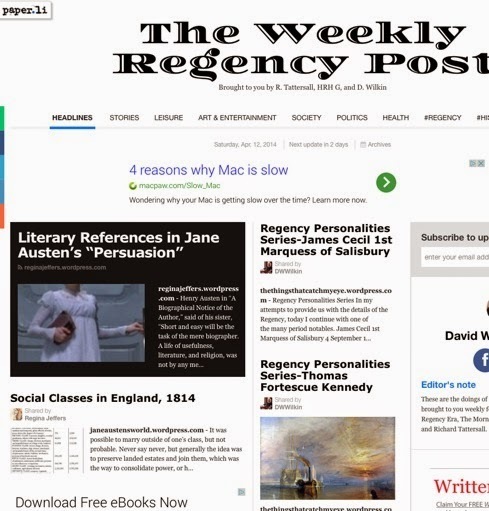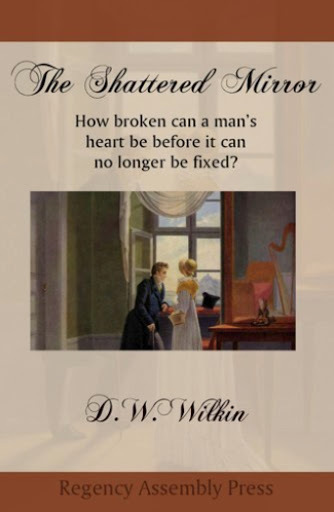D.W. Wilkin's Blog, page 175
October 19, 2014
Regency Personalities Series-Maria Molyneux Countess of Sefton
Regency Personalities Series
In my attempts to provide us with the details of the Regency, today I continue with one of the many period notables.
Maria Molyneux Countess of Sefton
26 April 1769 – 1 January 1851
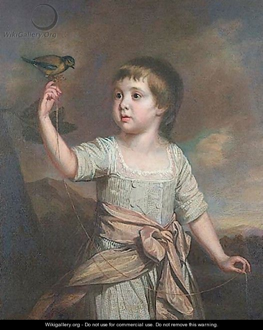
Maria Margaret Craven
Born Maria Margaret Craven, she was the daughter of William Craven, 6th Baron Graven and Hampsted Marshall and Lady Elizabeth Berkley on April 26, 1769. Her mother was the daughter of the 4th Earl of Berkley.
On Jan. 1, 1792, Maria married William Philip Molyneux, Viscount Sefton, the son of Charles William Molyneux, 1st Earl of Sefton, and Isabella Stanhope (daughter of the 2nd Earl of Harrington).
Little is known of Lady Sefton outside of her presence as a patroness of Almacks and being Lord Sefton;s wife. As a patroness her reputation is that of being good-natured. That she left blackballing to the other patronesses. The same with the revoking of vouchers of erring members. Lord Sefton was a very active member of society so it was natural that Maria become a patroness, especially as Lord Sefton’s mother was a founding member of Almacks. The couple had at least five children, and possibly more. Maria was a patroness at least by 1812 and may at that time have been the oldest patroness of the group. The couple lived in Arlington Street and she would have been very busy managing that household and her family. There were also residences at Stokes Farm in Berkshire and Croxteth Hall near Liverpool.
In 1814 Lord Sefton fell out with Prinny over trying to exclude the Prince Regent from the White’s Club Ball, which was cancelled. This may have caused Lady Sefton to be excluded from court functions as it did Lord Sefton. However her activity as Patroness of Almacks did not decline for another ten years. William IV restored Lord Sefton to court life as William was an admirer of Sefton. Maria survived her husband by more than a decade dying January 1 of 1851.


The Weekly Regency Post
A play upon The Morning Post that was published in the Regency Era. A newspaper owned by R. Tattersall and His Royal Highness, Prince George.
This is a weekly wrap-up of posts from various sources who write regency posts brought to you on a Sunday.
Visit at The Weekly Regency Post


October 18, 2014
Regency Personalities Series-Sir William Parker Baronet of Shenstone
Regency Personalities Series
In my attempts to provide us with the details of the Regency, today I continue with one of the many period notables.
Sir William Parker Baronet of Shenstone
1 December 1781 – 13 November 1866
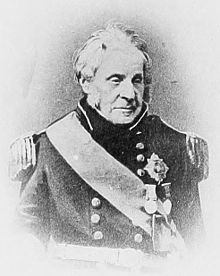
William Parker
Born the son of George Parker (himself the second son of Sir Thomas Parker who had been Lord Chief Baron of the Exchequer), William Parker entered the Royal Navy in February 1793 as a captain’s servant on the third-rate HMS Orion, serving under Captain John Duckworth. In the Orion, which was part of the Channel Fleet commanded by Lord Howe, Parker took part in the Battle of The Glorious First of June in June 1794 during the French Revolutionary Wars. When Captain Duckworth was assigned to another ship, the third-rate HMS Leviathan, Parker followed him, and sailed with him to the West Indies Station where Duckworth appointed him acting lieutenant in the fifth-rate HMS Magicienne. He was appointed to the second-rate HMS Queen, flagship of Admiral Sir Hyde Parker, in May 1798 and he became acting captain of the sixth-rate HMS Volage on 1 May 1799. Promoted to lieutenant on 5 September 1799, he cruised for the next few months in HMS Volage in the Gulf of Mexico and off the coast of Cuba. Promoted to commander on 10 October 1799, he was given command of the sloop HMS Stork in November 1799. He returned to England and then spent nearly a year in HMS Stork in the North Sea or with the blockade fleet off Brest.
Promoted to captain on 9 October 1801, Parker assumed command of the sixth-rate HMS Alarm in March 1802 and then the fifth-rate HMS Amazon in October 1802 and remained with her for the next 9 years. The Amazon was attached to the fleet under Admiral Lord Nelson engaged in the pursuit of the French fleet to the West Indies. She was then sent on a cruise westward and therefore missed the Battle of Trafalgar. The Amazon was later attached to a squadron under Admiral Sir John Warren, participating in the capture of the French ships Marengo and Belle Poule at the Action of 13 March 1806 during the Napoleonic Wars. After Amazon was paid off in January 1812, Parker went onto half-pay. He was appointed a Companion of the Order of the Bath on 4 June 1815.
Parker purchased Shenstone Lodge near Lichfield, where he lived for the next 15 years. He returned to sea as captain of the third-rate HMS Warspite in 1827, and acted as senior officer off the coast of Greece in 1828. He was given command the yacht HMS Prince Regent in December 1828 and, having been promoted to rear-admiral on 22 July 1830, he was appointed second-in-command of the Channel Squadron, under Sir Edward Codrington, in April 1831. He was detached on an independent command on the Iberian Tagus River, hoisting his flag aboard the second-rate HMS Asia, in September 1831 with a mission to protect British interests during the Portuguese Civil War. He was advanced to Knight Commander of the Order of the Bath on 16 July 1834.
Parker returned to England and briefly served as Second Naval Lord in the Wellington caretaker ministry from August 1834 to December 1834. He became Second Sea Lord again, this time in the Second Melbourne ministry, in April 1835. Promoted to rear-admiral on 10 January 1837, he left the Admiralty to become Commander-in-chief of the East Indies and China Station, hoisting his flag in the third-rate HMS Cornwallis, in June 1841. He provided naval support at the Battle of Amoy in August 1841, and having been promoted to vice-admiral on 23 November 1841, also took part in the Battle of Ningpo in March 1842, the Battle of Woosung in June 1842 and the Battle of Chinkiang in July 1842 during the First Opium War.
Parker was advanced to Knight Grand Cross of the Order of the Bath on 2 December 1842, given a substantial good-service pension on 26 April 1844 and awarded a baronetcy on 11 November 1844. He became Commander-in-Chief, Mediterranean Fleet, hoisting his flag in the first-rate HMS Hibernia in February 1845. In May 1846, because of his knowledge of Portugal and its politics, he was given the additional command of the Channel Squadron while still remaining in charge of the Mediterranean Fleet. He was briefly (for a week) First Naval Lord in the First Russell ministry from 13 July 1846 to 24 July 1846 but gave up the role due to ill health before returning to his command with the Mediterranean Fleet.
Promoted to full admiral on 29 April 1851, Parker became Commander-in-Chief, Plymouth in May 1854. He retired in May 1857, and, having been promoted to Admiral of the Fleet on 27 April 1863, he died from bronchitis on 13 November 1866. He was buried in the churchyard at St John the Baptish Parish Church in Shenstone, and a monument to his memory was erected in Lichfield Cathedral.
In 1810 Parker married Frances Anne Biddulph; they had two sons and six daughters.


October 17, 2014
Regency Personalities Series-Francis Russell 7th Duke of Bedford
Regency Personalities Series
In my attempts to provide us with the details of the Regency, today I continue with one of the many period notables.
Francis Russell 7th Duke of Bedford
13 May 1788 – 14 May 1861
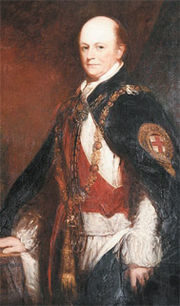
Francis Russell
Francis Russell 7th Duke of Bedford was the son of John Russell, 6th Duke of Bedford and his first wife the Hon. Georgiana Byng, second daughter of George Byng, 4th Viscount Torrington. Russell was educated at Westminster School and graduated from Trinity College, Cambridge in 1808, with a Master of Arts. He succeeded his father as duke in 1839.
He entered the British House of Commons in 1809, sitting as Member of Parliament for Peterborough in the next three years. Subsequently Russell represented Bedfordshire until 1832. In the following year, he was summoned to the House of Lords in his father’s junior title Baron Howland of Streatham by a writ of acceleration. Russell was sworn of the Privy Council on 6 July 1846 and was invested as a Knight of the Order of the Garter on 26 March 1847. He was made a Special Deputy Warden of the Stannaries in 1852 and was appointed Lord Lieutenant of Bedfordshire in 1859, a post he held until his death in 1861.
Russell was the elder brother of John Russell, 1st Earl Russell, who was twice Prime Minister of Britain.
On 8 August 1808, he married the Hon. Anna Maria Stanhope, daughter of Charles Stanhope, 3rd Earl of Harrington, and had by her a son.
Russell died in 1861, aged 73, and was buried on 22 May at Chenies, Buckinghamshire. He was succeeded in his titles by his only son William.


An Unofficial Guide to how to win the Scenarios of Wild the 2nd Expansion for Rollercoaster Tycoon 3
An Unofficial Guide to how to win the Scenarios of Wild
I have been a fan of this series of computer games since early in its release of the very first game. That game was done by one programmer, Chris Sawyer, and it was the first I recall of an internet hit. Websites were put up in dedication to this game where people showed off their creations, based on real amusement parks. These sites were funded by individuals, an expense that was not necessarily as cheap then as it is now. Nor as easy to program then as it might be to build a web page now.
Prima Books released game guides for each iteration of the game, Rollercoaster Tycoon 1, Rollercoaster Tycoon 2 and Rollercoaster Tycoon 3 (RCT3) but not for the expansion sets. And unlike the first two works, the third guide was riddle with incorrect solutions. As I played the game that frustrated me. And I took to the forums that Atari, the game publisher hosted to see if I could find a way to solve those scenarios that the Prima Guide had written up in error. Not finding any good advice, I created my own for the scenarios that the “Official” Guide had gotten wrong.
Solutions that if you followed my advice you would win the scenario and move on. But if you followed the “Official” version you would fail and not be able to complete the game. My style and format being different than the folks at Prima, I continued for all the Scenarios that they had gotten right as well, though my solutions cut to the chase and got you to the winner’s circle more quickly, more directly.
My contributions to the “Official” Forum, got me a place as a playtester for both expansions to the game, Soaked and Wild. And for each of these games, I wrote the guides during the play testing phase so all the play testers could solve the scenarios, and then once again after the official release to make changes in the formula in case our aiding to perfect the game had changed matters. For this, Atari and Frontier (the actual programmers of the game) placed me within the game itself.
And for the longest time, these have been free at the “Official” Forums, as well as my own website dedicated to the game. But a short time ago, I noticed that Atari, after one of its bankruptcies had deleted their forums. So now I am releasing the Guide for one and all. I have added new material and it is near 100 pages, just for the first of the three games. It is available for the Kindle at present for $2.99.
(Click on the picture to purchase)
Not only are all 12 Scenarios covered, but there are sections covering every Cheat Code, Custom Scenery, the famous Small Park Competition, the Advanced Fireworks Editor, the Flying Camera Route Editor which are all the techniques every amusement park designer needs to make a fantastic park in Rollercoaster Tycoon 3.


October 16, 2014
Regency Personalities Series-Henry Benedict Stuart
Regency Personalities Series
In my attempts to provide us with the details of the Regency, today I continue with one of the many period notables.
Henry Benedict Stuart
6 March 1725 – 13 July 1807
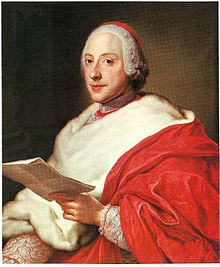
Henry Benedict Stuart
Henry Benedict Stuart was born in exile at the Palazzo Muti in Rome on 6 March 1725 and baptized on the same day by Pope Benedict XIII, 37 years after his grandfather James II and VII lost the throne, and ten years after his father’s failed attempt to regain it. His father was James Francis Edward Stuart, known to his opponents as “the Old Pretender”. His mother was the Princess Maria Klementyna Sobieska, granddaughter of the Polish King, John III Sobieski.
Henry went to France in 1745 to help his brother, Prince Charles Edward Stuart (“Bonnie Prince Charlie”, or “the Young Pretender”) prepare the Jacobite campaign of that year. After its defeat, Henry Stuart returned to Italy. On 30 June 1747 Pope Benedict XIV conferred him with tonsure and created him Cardinal-Deacon of S. Maria in Portico in a special consistory held on the 3 July 1747. On 27 August 1747 he was promoted to the four minor orders by the Pope. He received the subdiaconate on 18 August 1748 and diaconate on 25 August 1748. He was ordained priest on 1 September 1748 and consecrated titular Archbishop of Corinth on 2 October 1758.
He was advanced to the order of Cardinal Priest in 1748, maintaining title to S. Maria in Portico. In 1752 he transferred to the titulus of Ss. XII Apostoli. He was made Cardinal-Bishop of Frascati on 13 July 1761, and eventually succeeded to the See of Ostia and Velletri on his appointment as Dean of the Sacred College of Cardinals on 26 September 1803. He lived and worked in Frascati for many years, descending each afternoon in his carriage to Rome, where his position as vice-chancellor entitled him to the Palazzo della Cancelleria.
His revenues from the many ecclesiastical preferments he enjoyed were enormous. His income from abbeys and other pluralities in Flanders, Spain, Naples and France amounted to 40,000 Pounds in British money at the time. He also held sinecure benefices yielding revenues in Spanish America. He owned territory in Mexico, which contributed largely to his income.
Henry was the last claimant to the British throne to touch for the King’s Evil.
At the time of the French Revolution, he lost his French Royal benefices and sacrificed many other resources to assist Pope Pius VI. This, in addition to the seizure of his Frascati property by the French, caused him to descend into poverty. The British Minister in Venice arranged for Henry to receive an annuity of £4,000 from King George III of Great Britain. Although the British government represented this as an act of charity, Henry and the Jacobites considered it to be a first installment on the money which was legally owed to him. (For many years the British government had promised to return the English dowry of his grandmother, Mary of Modena, but never did so.)
Henry returned to Frascati in 1803. In September of that year he became the Dean of the College of Cardinals and hence Cardinal Bishop of Ostia and Velletri, though he still lived in the episcopal palace at Frascati. He died there on 13 July 1807, aged 82.


Fantasy from Space Opera Books, Trolling’s Pass and Present
Trolling’s Pass and Present
Not only do I write Regency and Romance, but I also have delved into Fantasy. The Trolling series, (the first three are in print) is the story of a man, Humphrey.
We meet him as he has left youth and become a man with a man’s responsibilities. We follow him in a series of stories that encompass the stages of life.
We see him when he starts his family, when he has older sons and the father son dynamic is tested. We see him when his children begin to marry and have children, and at the end of his life when those he has loved, and those who were his friends proceed him over the threshold into death.
All this while he serves a kingdom troubled by monsters. Troubles that he and his friends will learn to deal with and rectify.
It is now available in a variety of formats. For $2.99 you can get this fantasy adventure.
Barnes and Noble for your Nook
Years since their battles with the Trolls, even on foreign soil, the warriors of the Valley Kingdom of Torahn need something to keep their edge honed.
The economy too is beginning to fray a little without the great wars to support. The Leaders hit upon the idea of searching for a path to reach the east side of the continent.
The Elves swear that at one time their writings tell of such, the Dwarves swear such a pass across Teantellen is legendary. Teantellen though is filled with races man has never gotten along with well. Goblins, Dark Elves, Trolls, Giants and Dragons.
It has been years since the mountain tops exploded, and perhaps that has changed things enough that a way can be found to link the western lands with the eastern lands and increase trade, and prosperity for all. Even should they fail in their quest, as the history of man has shown to this point in time, the attempt will do much to spur the economy.
Tens of thousands of gold will be spent by the Council of Twenty-One to pay for such an expedition. Gold that those who are not so scrupulous might choose to pocket as they tried in the Troll Wars.
With such shenanigans taking place again, are the hopes of the previous generation, the leaders from the Troll Wars now in retirement, ready to be achieved? Is it time for Torahn, called the Valley Kingdom, but the only Kingdom without a King, to have a King once more?
Feedback
If you have any commentary, thoughts, ideas about the book (especially if you buy it, read it and like it ;-) then we would love to hear from you.


October 15, 2014
Regency Personalities Series-James Byres
Regency Personalities Series
In my attempts to provide us with the details of the Regency, today I continue with one of the many period notables.
James Byres
1733 — 1817
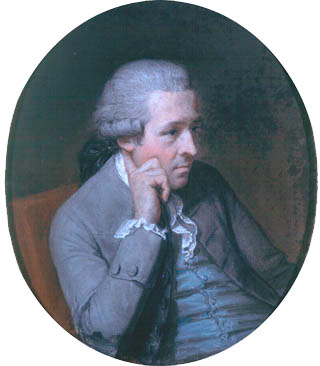
James Byres
James Byres of Tonley was a Scottish architect, antiquary and dealer in Old Master paintings and antiquities, a member of a family of Scottish Jacobite sympathisers who settled in Rome in 1758, where he became a cicerone to Scottish and English gentlemen on the Grand Tour until his return to Scotland in 1790. His house was in Via Paolina.
Byres was a painter and an adept designer, whose Vanvitellian design for a palazzo facade won a prize from the Accademia di San Luca in 1762. In Rome members of his circle were drawn by Angelica Kauffman in a sketchbook she used from 1762 to 1764: the portraits include the English painter Nathaniel Dance, Gavin Hamilton, and the abbé Peter Grant. By 1764 he was so well acquainted with the ancient sites and the cabinets of collectors that he took about a party of colonial Americans, including Samuel Powel of Philadelphia, who unlike his British peers, took assiduous notes.
William Constable purchased from Byres many of the Italian paintings and marble copies after Roman sculptures at Burton Constable, Yorkshire, and Byres was responsible for introducing the artist Anton Maron, who painted William Constable and his sister in the pose and dress of Cato and Marcia. Among the antiquities that passed through his hands, the most famous may be the Portland Vase, which he sold to Sir William Hamilton in 1770. Among the commissions for which he acted as agent was the Noli me Tangere of Raphael Mengs, 1771, for an altarpiece for All Souls College, 1771.
A clear idea of his own collection can be gleaned from a 1790 inventory made upon his return to Tonley. Though he sent many of his clients to Pompeo Batoni, the only Batoni portrait hanging in his house was of his sister Isabella, Mrs Robert Sandilands.
Concerning the Etruscans Byres formulated the hypothesis that Etruscan literature has not come down to us because it was purposely destroyed by the Romans.
Before he left Rome in 1790 he made a payment to the maître d’hôtel of Henry Benedict Stuart, Cardinal York in favour of the Duchess of Albany, illegitimate daughter of Bonnie Prince Charlie, so it may be inferred that his Jacobite sensibility ran deep.


RAP has The Shattered Mirror, A Regency Romance
The Shattered Mirror
For your enjoyment, one of the Regency Romances I published. It is available for sale and now at a reduced price, and I hope that you will take the opportunity to order your copy.
Order for yourself or as a gift. It is now available in a variety of formats. For just a few dollars this Regency Romance can be yours for your eReaders or physically in Trade Paperback.
Barnes and Noble for your Nook
and in Trade Paperback
Bridget Halifax-Stokes was giddy with the excitement of her season in London. Town had beckoned and her season came on the heels of the end of the war against the tyrant.
All the handsome men were returning heroes. What better year to come out.
Her father thought it all nonsense. Her mother believed that it would be the best showing of any of her daughters.
More lords available and luck that Bridget was just the perfect age.
All is fun and frivolity until Bridget literally crashes into Sir Patrick Hampton as he limps along the high street. A man she knew once well, now a stranger with dark and foreboding eyes.
Feedback
If you have any commentary, thoughts, ideas about the book (especially if you buy it, read it and like it ;-) then we would love to hear from you.


October 14, 2014
Regency Personalities Series-Samuel Rogers
Regency Personalities Series
In my attempts to provide us with the details of the Regency, today I continue with one of the many period notables.
Samuel Rogers
30 July 1763 – 18 December 1855
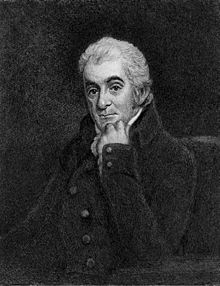
Samuel Rogers
Samuel Rogers was born at Newington Green, then a village north of Islington, London. His father, Thomas Rogers, a banker, was the son of a Stourbridge glass manufacturer, who was also a merchant in Cheapside. Thomas married Mary, the only daughter of his father’s partner, Daniel Radford, becoming himself a partner shortly afterwards. On his mother’s side Samuel Rogers was connected with the well-known English Dissenters clergymen Philip Henry and his son Matthew, was brought up in Nonconformist circles, and became a long-standing member of the Unitarian congregation at Newington Green, then led by the remarkable Dr Richard Price. He was educated in Hackney and Stoke Newington.
Two nephews, orphaned young and for whom he assumed responsibility, were Samuel Sharpe, the Egyptologist and translator of the Bible, and his younger brother Daniel, the early geologist.
Samuel Rogers wished to enter the Presbyterian ministry, but his father persuaded him to join the banking business in Cornhill. In long holidays, necessitated by delicate health, Rogers became interested in English literature, particularly the work of Samuel Johnson, Thomas Gray and Oliver Goldsmith. He learned Gray’s poems by heart, and his family wealth allowed him to leisure to try writing poetry himself. He began with contributions to the Gentleman’s Magazine, and in 1786 he published a volume containing some imitations of Goldsmith and an “Ode to Superstition” in the style of Gray.
In 1788 his elder brother Thomas died, and Samuel’s business responsibilities were increased. In the next year he paid a visit to Scotland, where he met Adam Smith, Henry Mackenzie, Hester Thrale and others. In 1791 he was in Paris, and enjoyed the Orleans Collection of art at the Palais Royal, many of the treasures of which were later to pass into his possession. With Gray as his model, Rogers took great pains in polishing his verses, and six years elapsed after the publication of his first volume before he printed his elaborate poem on The Pleasures of Memory (1792) – regarded by some as the last embodiment of the poetic diction of the 18th century. The theory of elevating and refining familiar themes by abstract treatment and lofty imagery is taken to extremes. In this art of “raising a subject”, as the 18th century phrase was, the Pleasures of Memory is much more perfect than Thomas Campbell’s Pleasures of Hope, published a few years later in imitation. Byron said of it, “There is not a vulgar line in the poem.”
In 1793 his father’s death gave Rogers the principal share in the banking house in Cornhill, and a considerable income. He left Newington Green and established himself in chambers in the Temple. Within his intimate circle at this time were his best friend, Richard Sharp (Conversation Sharp), and the artists John Flaxman, John Opie, Martin Shee and Henry Fuseli. He also made the acquaintance of Charles James Fox, with whom he visited the galleries in Paris in 1802, and whose friendship introduced him to Holland House. In 1803 he moved to 22 St James’s Place, where for fifty years he entertained all the celebrities of London. Flaxman and Charles Alfred Stothard had a share in the decoration of the house, which Rogers virtually rebuilt, and proceeded to fill with works of art. His collections at his death realised £50,000.
An invitation to one of Rogers’s breakfasts was a formal entry into literary society, and his dinners were even more select. His social success was due less to his literary position than to his powers as a conversationalist, his educated taste in all matters of art, and no doubt to his sarcastic and bitter wit, for which he excused himself by saying that he had such a small voice that no one listened if he said pleasant things. “He certainly had the kindest heart and unkindest tongue of any one I ever knew,” said Fanny Kemble. He helped the poet Robert Bloomfield, he reconciled Thomas Moore with Francis Jeffrey Jeffrey and with Byron, and he relieved Sheridan’s difficulties in the last days of his life. Moore, who refused help from all his friends, and would only owe debts to his publishers, found it possible to accept help from Rogers. He procured a pension for HF Cary, the translator of Dante, and obtained Wordsworth his sinecure as distributor of stamps.
Rogers was in effect a literary dictator in England. He made his reputation by The Pleasures of Memory when William Cowper’s fame was still in the making. He became the friend of Wordsworth, Walter Scott and Byron, and lived long enough to give an opinion as to the fitness of Alfred Tennyson for the post of Poet Laureate. Alexander Dyce, from the time of his first introduction to Rogers, was in the habit of writing down the anecdotes with which his conversation abounded. In 1856 he arranged and published selections as Recollections of the Table-Talk of Samuel Rogers, to which is added Porsoniana. Rogers himself kept a notebook in which he entered impressions of the conversation of many of his distinguished friends—Fox, Edmund Burke, Henry Grattan, Richard Porson, John Horne Tooke, Talleyrand, Lord Erskine, Scott, Lord Grenville and the Duke of Wellington. They were published by his nephew William Sharpe in 1859 as Recollections by Samuel Rogers; Reminiscences and Table-Talk of Samuel Rogers, Banker, poet, and Patron of the Arts, 1763–1855 (1903), by GH Powell, is an amalgamation of these two authorities. Rogers held various honorary positions: he was one of the trustees of the National Gallery; and he served on a commission to inquire into the management of the British Museum, and on another for the rebuilding of the Houses of Parliament.
He was elected a Fellow of the Royal Society in November 1796.
His literary production remained slow. An Epistle to a Friend (the above-mentioned Conversation Sharp), published in 1798, describes Rogers’s ideal of a happy life. This was followed by The Voyage of Columbus (1810), and by Jacqueline (1814), a narrative poem, written in the four-accent measure of the newer writers, and published in the same volume with Byron’s Lara. His reflective poem on Human Life (1819), on which he had been engaged for twelve years, is written in his earlier manner.
In 1814 Rogers made a tour on the Continent with his sister Sarah. He travelled through Switzerland to Italy, keeping a full diary of events and impressions, and had made his way to Naples when the news of Napoleon’s escape from Elba obliged him to hurry home.
Seven years later he returned to Italy, paying a visit to Byron and Shelley at Pisa. Out of the earlier of these tours arose his last and longest work, Italy. The first part was published anonymously in 1822; the second, with his name attached, in 1828. It was at first a failure, but Rogers was determined to make it a success. He enlarged and revised the poem, and commissioned illustrations from J.M.W. Turner, Thomas Stothard and Samuel Prout. These were engraved on steel in the sumptuous edition of 1830. The book then proved a great success, and Rogers followed it up with an equally sumptuous edition of his Poems (1834). In 1850, on Wordsworth’s death, Rogers was asked to succeed him as poet laureate, but declined the honour on account of his age. For the last five years of his life he was confined to his chair in consequence of a fall in the street. He died in London, and is buried in the family tomb in the churchyard of St Mary’s Church, Hornsey High Street, Haringey.



